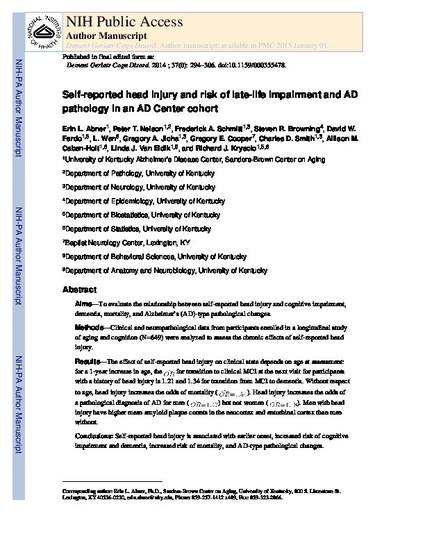
Aims: To evaluate the relationship between self-reported head injury and cognitive impairment, dementia, mortality, and Alzheimer's disease (AD)-type pathological changes. Methods: Clinical and neuropathological data from participants enrolled in a longitudinal study of aging and cognition (n = 649) were analyzed to assess the chronic effects of self-reported head injury. Results: The effect of self-reported head injury on the clinical state depended on the age at assessment: for a 1-year increase in age, the OR for the transition to clinical mild cognitive impairment (MCI) at the next visit for participants with a history of head injury was 1.21 and 1.34 for the transition from MCI to dementia. Without respect to age, head injury increased the odds of mortality (OR = 1.54). Moreover, it increased the odds of a pathological diagnosis of AD for men (OR = 1.47) but not women (OR = 1.18). Men with a head injury had higher mean amyloid plaque counts in the neocortex and entorhinal cortex than men without. Conclusions: Self-reported head injury is associated with earlier onset, increased risk of cognitive impairment and dementia, increased risk of mortality, and AD-type pathological changes.
This work was supported by grants to the University of Kentucky's Sanders-Brown Center on Aging from the National Institute on Aging (grant No. R01 AG038651, R01 AG019241, and P30 AG028383), as well as a grant from the National Center for Advancing Translational Sciences to the University of Kentucky's Center for Clinical and Translational Science (grant No. UL1TR000117).
Available at: http://works.bepress.com/steven_browning/50/

Published in Dementia and Geriatric Cognitive Disorders, v. 37, no. 5-6, p. 294-306.
© 2013 S. Karger AG, Basel
This is the peer-reviewed but unedited manuscript version of the following article: Abner, E. L., Nelson, P. T., Schmitt, F. A., Browning, S. R., Fardo, D. W., Wan, L., Jicha, G. A., Cooper, G. E., Smith, C. D., Caban-Holt, A. M., Van Eldik, L. J., & Kryscio, R. J. (2014). Self-reported head injury and risk of late-life impairment and ad pathology in an ad center cohort. Dementia and Geriatric Cognitive Disorders, 37 (5-6), 294-306. doi: 10.1159/000355478. The final, published version is available at http://www.karger.com/?doi=10.1159/000355478.